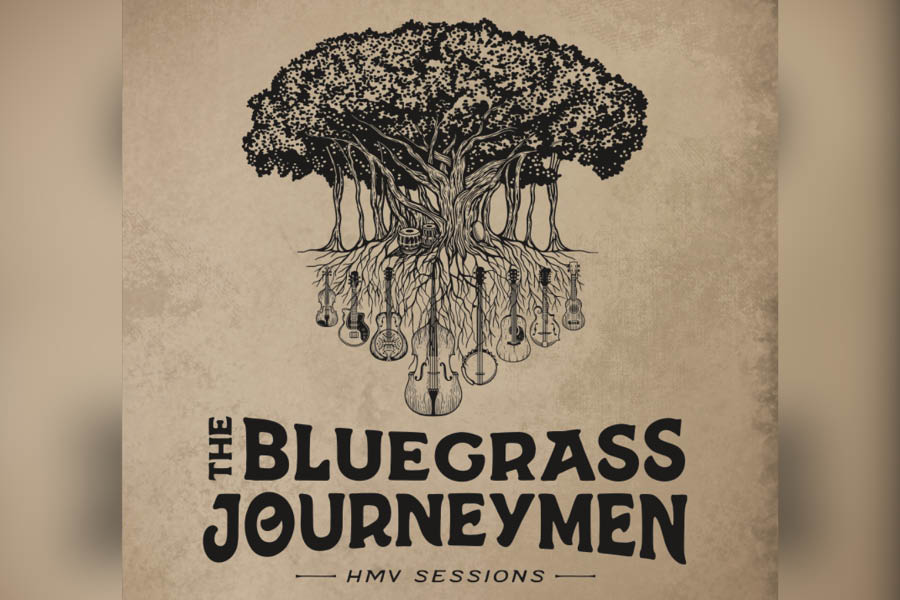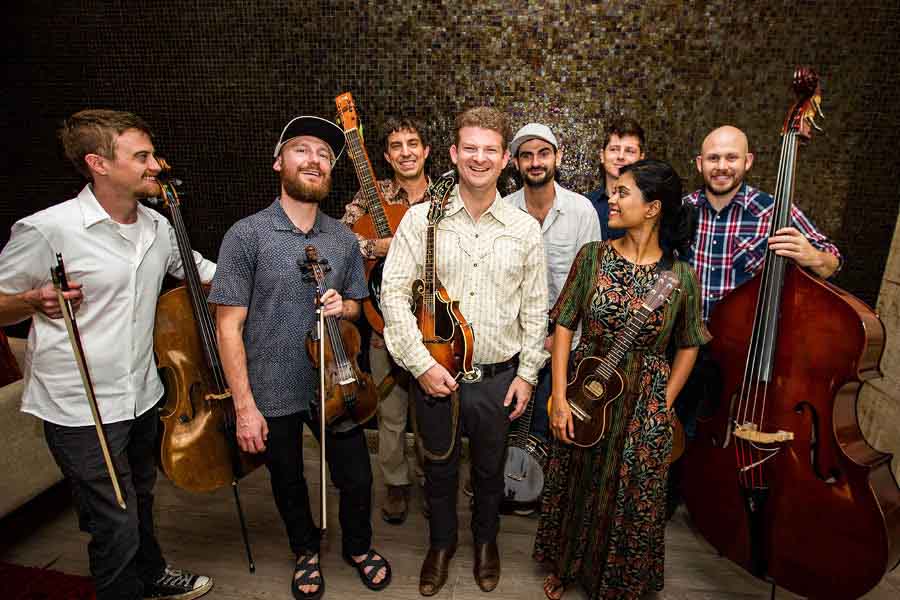The Bluegrass Journeymen (TBJ) took root in 2017 when mandolin player Patrick Fitzsimons set out to introduce the bluegrass genre to India. Following their third tour in the country, the band captured the creative results of their cross-cultural musical explorations abroad, which laid the groundwork for their debut album, HMV Sessions.
The album not only features traditional bluegrass tracks like Helen, Paddy on the Turnpike and You Go to Your Church, but also explores a variety of other musical styles through the bluegrass lens. It includes interpretations of Klezmer music with tracks like Tanz Tanz Yidelekh, ventures into western classical with Pickin' on Paganini, and incorporates Bengali folk melodies such as Ei Shure Bohu Dure, Dokhina Batash, and Badal Baul Bajay Re Ektara. The album even takes on a Bollywood classic with Tujhe Dekha Toh.
This album was recorded in the historic HMV Studio in Kolkata, the site of India's first record-pressing plant and arguably the most significant recording studio in the early 1900s into the Bollywood era and beyond. Since its inception, the studio has hosted illustrious artistes, including Rabindranath Tagore, who recorded many of his compositions there. Classical legends like Bismillah Khan and Ravi Shankar also graced its hall, while legendary playback singers like Kishore Kumar and Asha Bhosle left their mark with numerous Bollywood hits. The studio’s archive preserves decades of recordings, offering a rich tapestry of India's musical evolution and cultural heritage.
Kolkata-based singer Nabanita ‘Bonnie’ Sarkar, a longstanding collaborator with TBJ, adds her vocals, ukulele, passion for bluegrass, and deep knowledge of Bengali folk songs to the ensemble. Reflecting on performing with TBJ, Nabanita remarks, "It signifies more than just a collaboration; it embodies the fusion of diverse traditions, sounds, and perspectives. This exchange expands both an artiste’s and the audience’s understanding and appreciation of global music."
The core recording band for HMV Sessions includes Patrick Fitzsimons on mandolin, mandola, mandocello, and vocals; Billy Cardine on dobro, chaturangui, melodica, and vocals; Coleman Smith on violin; Summers Baker on guitar and vocals; Andrew Conley on cello; Sean Niklin on banjo; and Jean Luc-Davis on the upright bass and vocals.

The album cover
They are joined by guest musicians Mary Lucey, Matt Menefee, Ryan Cavanaugh, Sam Armstrong-Zickefoose, Charles Parker Mertens, and River Guerguerian.
Mandolin Rajesh, renowned for his mastery of the electric mandolin rooted in the South Indian Carnatic tradition, also joins as a guest musician. Collaborating with his longtime tabla player, Praveen Narayan, he enriches the instrumental track Backyard Bhangra with fiddle and dobro elements.
Dobro master and recording engineer Billy Cardine recorded and produced HMV Sessions.
The album's diverse musical styles reflect TBJ's goal of spreading bluegrass globally and fostering cultural connections through music. By touring, performing, and collaborating, HMV Sessions captures the essence of TBJ's journey. It celebrates music as a universal language that bridges gaps and connects people, whether near or far.
My Kolkata spoke with Patrick about the band’s beginnings, their journey so far, their ties to Bengal, and more. Edited excerpts follow…
My Kolkata: What has the band been up to since its first major release? Are there any plans for TBJ to perform in India soon?
Patrick Fitzsimons: The band is currently touring Colorado, with upcoming performances at the Rapidgrass Festival on August 2 and 3 in Idaho Springs. We will be busy here in America since the album just came out.
Could you share more about how the band first came together and began its journey, particularly with the initial tours and connections to India and Bengal?
The band happened by happenstance, really. It first started with the initial tour in 2017. There wasn’t a big mission behind it. At the time, I had a friend from India and wanted to bring bluegrass over there. With such a high population of English speakers, I knew people would understand the words and relate a bit to what they were doing. It would be interesting to introduce a new foreign sound. In America, many people bring their indigenous folk music, and bluegrass and old-time music represent that for America. I wanted to try to represent that a little bit.
The connection to Bengal started with our first banjo player, George Guthrie, who even played on subsequent tours. He was part of the Facebook bluegrass network and told me about musicians from Kolkata, specifically the band No Strings Attached, which included Nabanita, Diptanshu Roy, and Koustav Dey. We hung out and played music with them on the first tour. On the second tour, Nabanita played in our band more frequently. I brought over Dobro player Billy Cardine, who also produced our first album. From there, we began writing more music and playing more gigs.
The band has gone through many different iterations of musicians. The only remaining member from the 2017 lineup is me. Originally, we were a traditional five-piece bluegrass band, aiming to bring that music to India. However, as new members joined, they brought their own sounds and influences, changing the band's intentions and style.
This album has been a long time coming. We started recording it in 2019, so it features older material. We have more music in the pipeline, but this album is a great start and representation of the Bengali bluegrass fusion. Some songs include Ashure Bahudure, Dokhina Batash, and the Rabindranath Tagore song Badal Baul Bajaye Re Ektara.
What are the distinctive instrumentation characteristics of bluegrass music, and how does its sound differ from traditional folk music?
Bluegrass music is often described as an orchestral form of American music. Bill Monroe, one of the founders of bluegrass, had a band called Bill Monroe and the Bluegrass Boys. He compared bluegrass music to an engine, where all the different instruments fit together to make the vehicle go. The mandolin provides the chop on the off-beat, the bass is on the one and three, the guitar covers the mid-range, the banjo gives the roll and drive, the fiddle offers the high notes or “high lonesome sound,” and the Dobro adds more colour.
What inspired you to blend bluegrass music with the Bengali language?
Well, that tradition already existed before I arrived. In the 1950s and ’60s, artists like Tom Paxton and Pete Seeger visited Kolkata, performed concerts, and made connections with local musicians. Arunendu Das, for example, took melodies from American folk songs and wrote Bengali lyrics for them. One such song is I Can't Help but Wonder Where I'm Bound, which he adapted into Bengali.
When I got to Kolkata, Nabanita and No Strings Attached were already playing these kinds of songs. They performed traditional Bengali folk songs with American fiddle tunes incorporated. This blending of styles wasn't my idea; it was an established practice when I arrived.
What do you find most fascinating about Kolkata and Bengal as a whole? Do you have any plans to visit anytime soon?
I find Kolkata to be a wonderful city. I've learned a bit about Rabindranath Tagore's works, reading his short stories and poetry and learning some of his songs. Bengali is a beautiful language, and I've taken up learning it as a hobby, picking up words gradually. It's challenging to keep up, but I'm taking lessons on Preply from my teacher, Bondona, a few days a week, along with Hindi lessons.
Kolkata and West Bengal, in general, are relaxing and warm places to be. I enjoy spending time in Kolkata, Darjeeling, Kalimpong, and Sikkim. The Kolkata biryani is a favourite of mine, especially from Arsalan, where I dined several times during my last trip. The maachh (fish) is delicious, and I love the spices and the hospitality. Wherever I go, I always get a warm welcome and plenty of food.
In November, I’m likely to visit during Thanksgiving or the winter break. I'm involved with schools in Kolkata, like Piali Ashar Alo near the Sunderbans and Gandhi Ashram in Kalimpong. I work with their music programmes and plan to visit them. Additionally, we’re starting a programme sending teachers to Kathmandu to teach bluegrass, and I'll probably go there next year.
Are there any Indian musicians you hope to collaborate with in the future?
I've been asked this question before, and my answer remains the same: I'd love for the Bluegrass Journeymen to be Arijit Singh's backing band. Imagine Arijit Singh performing bluegrass – it could definitely attract a lot of listeners and sell albums. Additionally, collaborating on a video mashup with Shah Rukh Khan would be fantastic.
What are your plans for the band moving forward? Can we expect new releases or a tour in India soon?
We're preparing to release new music soon. We also plan to release another live album of our performance at The Piano Man Jazz Club from our recent tour. TBJ will also be performing at the International Bluegrass Music Association (IBMA) ‘World of Bluegrass’ Conference in Raleigh, NC, promoting the album release.
